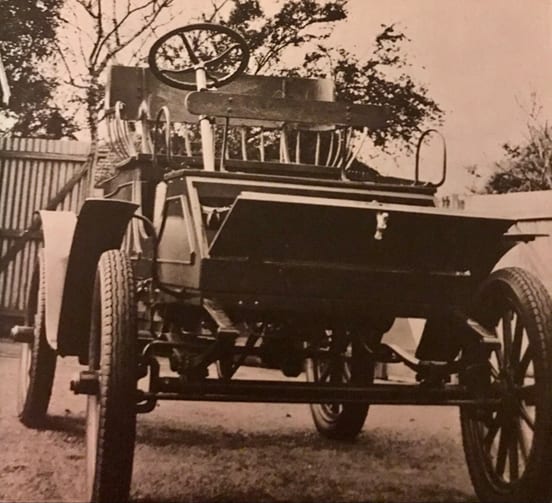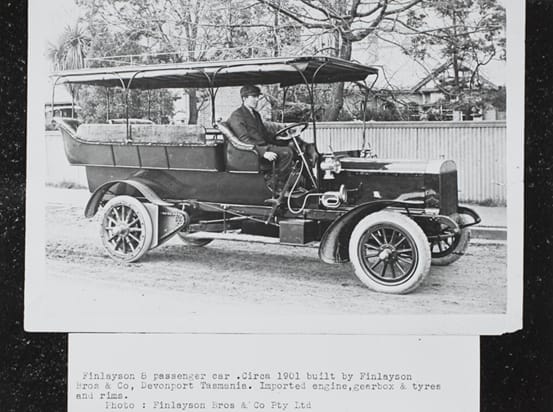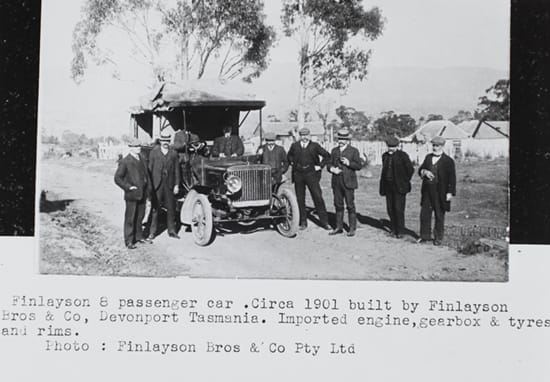
I first became aware of the Finlayson Bros cars while leafing through a copy of Marjory Bligh’s Tasmania and Beyond. I was about 12 and obsessed with local history, especially if it involved machinery.
The late Mrs Bligh granted the Finlayson automobile a mere paragraph, but that was sufficient to impart on me a lasting fascination with the company and its brief, almost forgotten dalliance with car manufacture.
I knew, of course, that there was a rich and enthusiastic car culture in Tasmania, but this seemed at its strongest in the 1960s and ’70s. Ground-up production at the dawn of the 20th century was an altogether different proposition, all the more remarkable given the degree of isolation that hindered the island, and the crudity and sparseness of its roads.
Finlayson Bros & Co Pty Ltd was an engineering and machining company based in Devonport. It was established in 1887 by James Finlayson at the River Don settlement and, as befitted the needs of an emerging industrial state, grew quickly. By the close of the 19th century, the company provided engineering and casting services to the agricultural and marine industries, as well as manufacturing farming equipment and household wares. This growth necessitated a move in 1889 to a larger engineering works on the banks of the Mersey River.
It was from here that the first automobile emerged in 1900, a light four-seater steam car. Quite what drew the firm to vehicle manufacture is, unfortunately, unknown, but it may be surmised that the entrepreneurial, industrious Finlaysons were simply as beguiled by the motor car as the rest of the world. Business was good, and so they were well-placed to venture into the emerging industry.
What cannot be disputed is the competence of the little car that materialised. Beneath a simple timber body, a kerosene boiler supplied steam at 200psi to a twin-cylinder, six-horsepower engine. Steam supply was regulated by a hand lever, with chain drive to the rear wheels. Two pedals protruded from the wooden floor: one was a brake, the other engaged reverse. The one-off car was retained by the company and used as a works vehicle around the factory and foundry for several years, until it was dismantled and relegated to the pattern loft.
There followed a series of commercial vehicles, ancient ancestors of the modern minibus, with production of the first starting about 1901. These rugged beasts of burden employed French Gnome engines, believed to be of four-litre, four-cylinder capacity, mated to Paice gearboxes. The coachwork was by F. Paine & Son of Launceston, coachbuilders of distinction, and followed a traditional charabanc style.
The Holyman shipping line bought three eight-seaters for use in Launceston, and two similar vehicles were supplied to the Thompson family of St Helens. These plied the east coast bus route for several years.
In 1906, Finlaysons graduated to 12-seaters, two of which were built on a lengthened version of the earlier chassis. These provided tourist transport for private operators. One went south to be employed on the Hobart-Huon run, whilst the other went to Mr G West, a Devonport coach operator, as reported in The Advocate in April 1906. A successful trial run from Devonport to Ulverstone was heralded in glowing terms, as was Mr West’s faith in the locally built machine.
Around this time, another small twin-cylinder private car was produced, apparently an experimental prototype. It was to be Finlayson’s last. The company, perhaps sensing growing competition from abroad, exited the automotive game in 1908. It was a wise and pragmatic decision – 1908 saw the birth of Henry Ford’s all-conquering Model T. Cheap, versatile and utilitarian, it was the death knell for countless small-scale carmakers.
The Finlayson cars may have been a mere footnote, but the company itself was no flash in the pan, continuing to provide engineering and machining services to Tasmania until the foundry finally closed in 1991 after 102 years of operation.

What is immediately apparent when reviewing grainy photographs of the Finlayson cars is the simple elegance of their design. Early steam cars tended to be hulking dinosaurs, heavy and cumbersome of construction, slow and laborious in operation.
By contrast, the Finlayson vehicles were compact, light (the first car weighed just 272kg) and attractive. Indeed, their relative modernity belied their birthplace – as far as can be imagined from the emerging giants of the UK, Germany and the US that would dominate the car industry in the decades that followed.
The Finlayson commercial vehicles led short, hard lives on the barely-made roads of Tasmania. Of the nine built between 1900–1908, only the very first is believed to survive today. That little steam car’s rapid obsolescence proved to be its saviour. It sat, quietly gathering dust and cobwebs in a forgotten corner of the pattern loft until the early 1960s, when it was found and restored by Bill Buchanan. It made its last public appearance in 1964, appropriately leading a procession across the newly opened Tasman Bridge in Hobart.
All that remains today is the eponymous Finlaysons Way in Devonport, a small reminder of a company that once dominated the north-west.

Jarah Weinreich was born in Lilydale and spent his childhood with the foothills of Mount Arthur as his playground. The landscape of rolling hills and deep, mystical forests enthralled me then as it does now. School enthralled him rather less, but did induce a love of words and stories. His writing has mainly covered local history and culture, often the obscure or largely forgotten. Today, Jarah Weinreich lives in Launceston where, when not working, reading or gardening, he plays with old cars.







